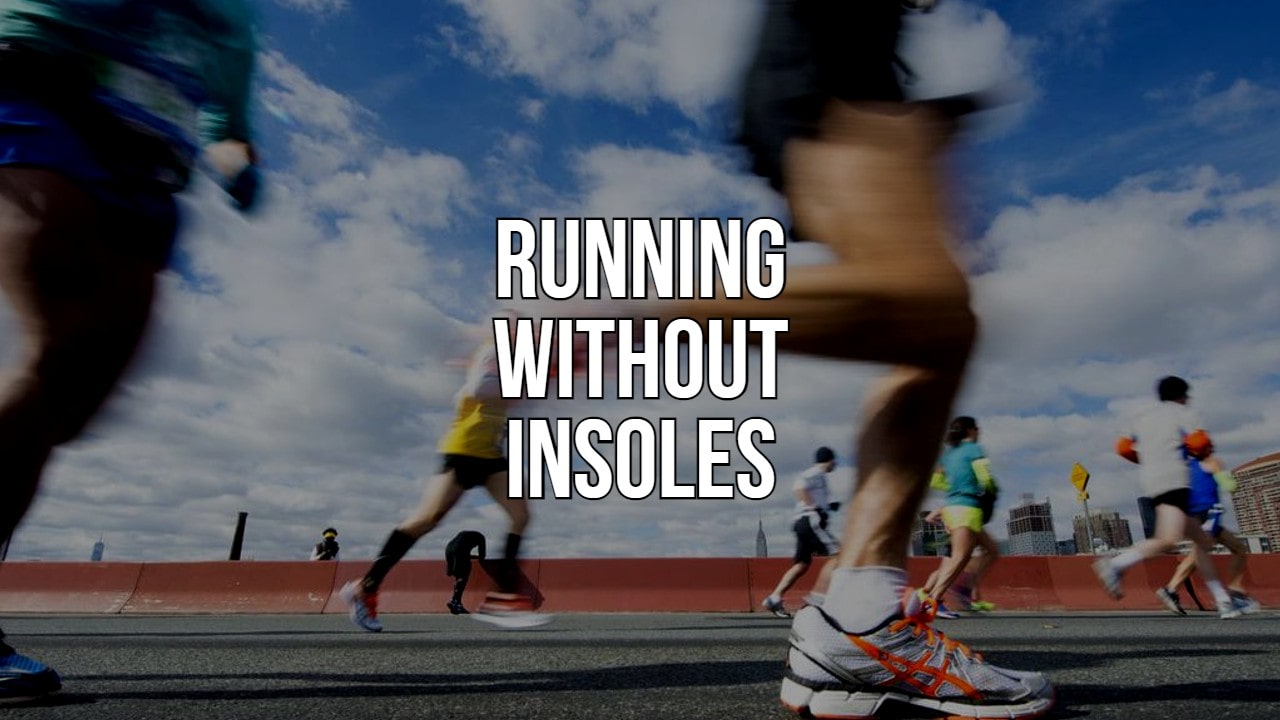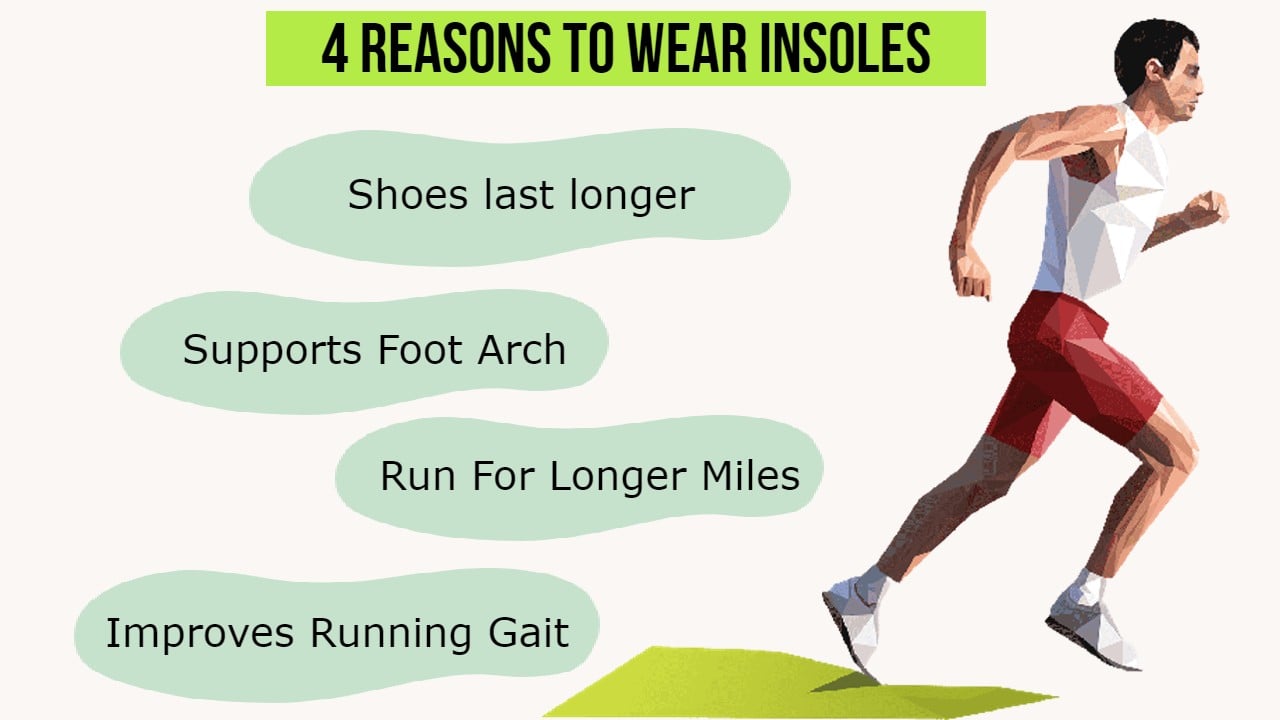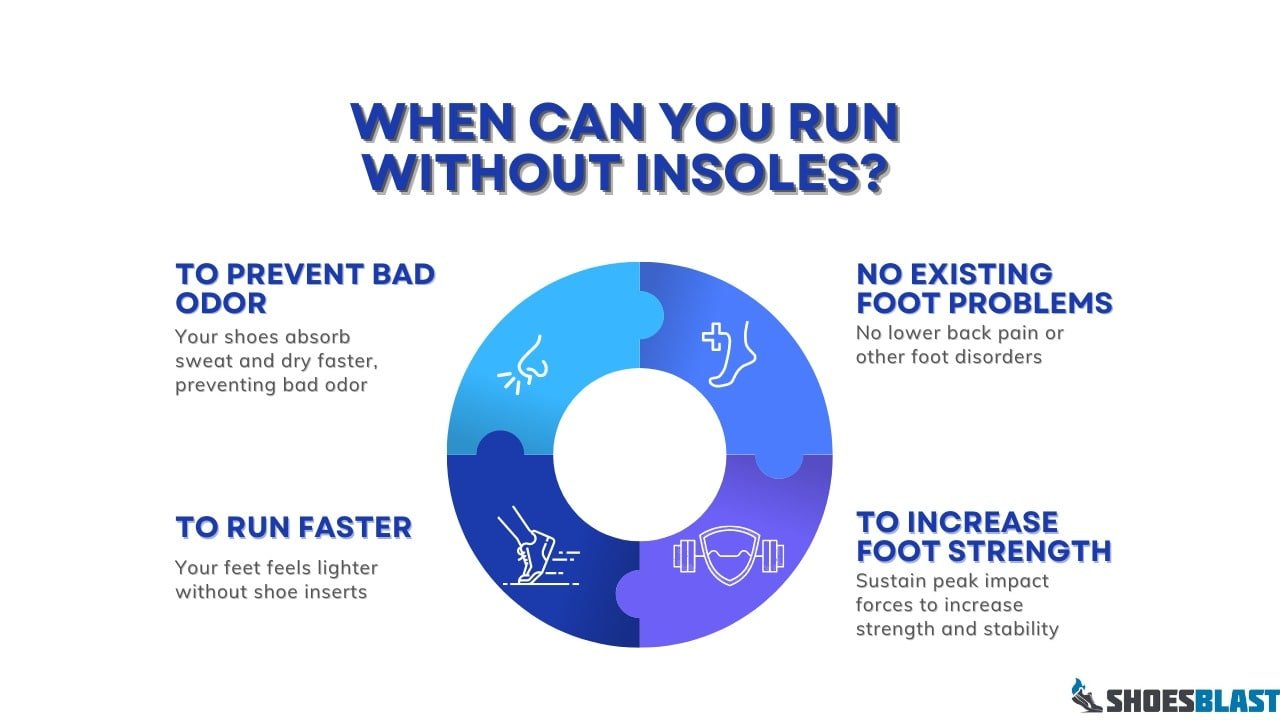Table of Contents
Do you get off the running track because your arch muscles get tired or weary? It is high time to narrow down the cause of discomfort and pain in your feet. It might be the right time to insert orthotics or insoles in your running shoes.
As runners, our feet and lower limb muscles constantly bear the wear and tear process. If you do not provide them enough support, they eventually wear out, leading to foot pain or swelling.
In this article, we’ll provide you with detailed insights to help you choose whether you can run with insoles or not. By highlighting some of the reasons you should consider insoles, and when you can run without insoles, we’ll beat about the bush.
Know About Insoles!
The thin inserts when you buy your running shoes are not solely meant to improve the fit of your shoes.
The point of these inner core layers is to give additional support to your feet and improve your running gait. However, these supportive layers are only in action if your foot fits perfectly in your shoes.
Almost all podiatrists advise runners to customize their insoles according to their shoes. Keep an owl’s eye check on your running stride while wearing insoles. If your shoe feels tight or your foot has minimum space to move around, it’s time to replace your insoles or run without them.
How Insoles Help Your Feet?
Whether hiking a peak or running for longer miles, a right insole for your feet gives additional benefits to runners by enhancing your running experience. Always remember, an insole will only work if it fits perfectly and doesn’t add stress to your lower limb.
Here are some of the benefits insoles can help boost your running performance.
1. Give Support
Customized insoles that are perfect for your feet provide enhanced support by dispersing the pressure evenly. They minimize the pressure on your feet, thereby realigning your feet.
Whether you’re a high or flat arch runner, insoles might be an ideal option for you to solve this problem. However, consult a podiatrist before choosing the right insole to confirm the type of orthotics best suited for your feet.
2. No Complains Of Loose Shoes Again
Do you feel that your feet slide back and forth when you run? No doubt, it is because you’re wearing loose shoes. Insoles come in handy when at this point to help your shoes fit perfectly.
While insoles fill out the space between your feet and shoe, it also facilitates the general stability of your running stride. With customized insoles, your feet and knees get better treatment.
Pay heed to how your feet move while you run. To enhance your running experience, you’ll need to take a few steps to solve the problems.
3. Absorb Shocks
The best part about putting shoe inserts is that you minimize the stress on your feet, thereby reducing the transfer of shock to your knees and hips.
Specific shock-absorbing insoles reduce the peak forces generated during foot strikes. Therefore, if you have plantar fasciitis or severe muscle or leg pain, orthotics eliminate foot fatigue by reducing shock across your feet.
Why Should You Use Insoles While Running?
1. Your Shoes Last Long
With insoles intact with your shoes, the wear and tear on your midsoles decreases, lengthening the shoe life. Replacing your favorite running shoes as casual or an athlete runner is challenging for some people. Therefore, if you have shoe inserts, you’ll run in the same pairs for a longer period. (See how many running shoes you have.)
Furthermore, you can take out insoles to wash them effortlessly, keeping your shoes fresh and clean. Guarding your shoes adds to their longevity and ensures a hustle-free running experience.
2. Supports Foot Arch
Wearing shoe insoles frequently helps with existing foot disorders and prevents future complications.
They reduce the chances of developing plantar fasciitis and bunions, especially if you have a flat arch.
In flat arch runners, the plantar fascia tissue gets excessively stretched during foot strikes. Consequently, your heel tendons get overworked, leading to plantar fasciitis. Wearing shoe inserts with a perfect arch will help prevent such conditions.
Note: Before deciding the type of insoles, consult a podiatrist or a nearby shoe expert to know the type of flat feet you have. You’ll need low arch insoles if you’ve flat feet with rigid foot arch. On the other hand, a flexible foot arch will need a medium arch insole.
3. Run for longer miles without getting tired
Average athletic runners can run for 3 miles per match but have you ever felt breathless or fatigued running after 1 mile only?
One of the reasons might be the minimum support from your shoes. If you ignore this nagging pain in your feet, it might extend to the knees and hips.
Wearing shoe insoles added extra support by giving a superior cushioning effect and enhancing the shock absorption capacity of your feet. In one study, scientists conclude that shoe inserts reduce peak impact forces during running.
Therefore, one fringe benefit of wearing insoles is that it will optimize your biomechanics by alleviating stress. Eventually, you’ll feel less tired and enjoy running for longer miles.
4. Improves your running gait
As an avid runner, you’ll feel that noticing your foot movements, on the whole, is essential for a balanced running pattern. Even minor foot posture problems can result in added amount of stress on your feet.
If you are a flat-feet runner, overpronation reduces the absorption of impact forces, resulting in an uneven running gait. Each time you strike your foot to the ground, an ample amount of force repeatedly transfers to your joints and ligaments. Therefore, experts advise runners to wear insoles to reduce abnormal lower body movements.
When Can You Run Without Insoles?
Leaving your insoles at home is acceptable, but doing so occasionally can cause severe damage. As an avid runner, you must know that not all runners need insoles. Remove your shoe inserts if you don’t have any serious injuries and wish to train your feet hardcore.
Go through these four reasons to wear shoes without insoles.
1. No Existing Foot Problems or Lower Back Injuries
Insoles are not always necessary, especially if you do not have any existing foot disorders or lower back pain. Nevertheless, most shoe experts recommend removing customized insoles but keeping the factory insole, which is the base insole.
If you have never suffered from plantar fasciitis, bunions, or muscle pain problems, leaving insoles at your home paves no harm. However, you must not run for longer miles without insoles in one go. Initially, your feet might not be used to increased pressure as there’s minimum support.
Try to start running with less time, take breaks, and gradually increase your running time.
2. To Increase Stability and Foot Strength
If you wish to train your feet on hard surfaces to build strength and sustain peak forces, you can remove shoe inserts. However, your feet might get sore and tired quickly when you first stop wearing insoles. But with time, as you keep running, your feet become resilient to stress, and you’ll feel ample strength in your balls, arch, and heels.
However, people with foot issues like tired muscles, painful tendons, or plantar fasciitis must not remove their orthotics. Make sure to consult a podiatrist before doing so.
3. To Run Faster
According to a study in 2016, restricting your run with insoles means restricting your arch’s function. Your insoles do the work of your arches by adding extra lift to your feet when you run. Consequently, your body’s total efficiency decreases by 6%, slowing down your pace.
Once you remove insoles from your shoes, your feet are lighter when running and your arch muscles return to function.
Still and all, further studies are required to study the effect of cushioned insoles on a runner’s biomechanics.
4. To Prevent Bad Odor
One advantage of wearing shoes without insoles is that it absorbs your sweat faster, slowing down bacteria production. As a result, your shoes will not smell bad because the leather inside the shoes dries up quickly.
When you return from the running track, keep your shoes in a cool and dry place. Also, reduce the smell by sprinkling odor-absorbent powders in your shoes.
4 Signals To Wear Insoles For Running Immediately
Some alarming calls that your body makes to wear orthotics are described below.
1. Foot or heel pain
It is high time to visit your podiatrist as soon as you repeatedly feel muscle or foot pain. Your podiatrist will narrow down the cause by investigating your pain duration and timings. Your feet possibly need support next time you run. Therefore, your doctor might recommend you wear orthotics.
2. If you’ve worn out shoes
Worn-out shoes clearly mean uneven foot patterns, leading to discomfort and injuries. You can temporarily fix this problem by wearing orthotics. However, according to podiatrists, replacing your running shoes with newer ones is best.
As a runner, you must watch out for signs that indicate changing your running shoes.
3. Flat foot or high arch
Custom insoles are essentially designed for runners who have flat feet. Special orthotics help flat feet runners to prevent pain and discomfort. However, consider flexibility, shoe volume, and the right orthotic size before you buy insoles.
Talk to your podiatrist to check if you require an insole with maximum comfort or flexibility. Shoe inserts that bend or roll easily are designed for comfort. On the other hand, flexible insoles don’t bend and provide adequate support to your feet. The type of insole you wear entirely depends on the type of foot you have.
4. Foot Complications
If you have foot disorders like plantar fasciitis, bunions, or arch and lower back pain, immediately go for shoe orthotics. While running, your feet need adequate support to alleviate the friction and shock from the ground during foot strikes. Hence, wearing orthotics is the right option.
Takeaway: Wear Running Shoes without insoles.
Overall, wearing shoe insoles depends on your foot health and running biomechanics. If your feet are healthy and do not need any support, you are good to go without insoles. However, if you have any existing foot conditions, or perhaps, you feel repeated lower limb pain, consult your podiatrist immediately and look for orthotics to add maximum support to your feet.

PharmD, Salim Habib University | A Medical and Healthcare Writer



